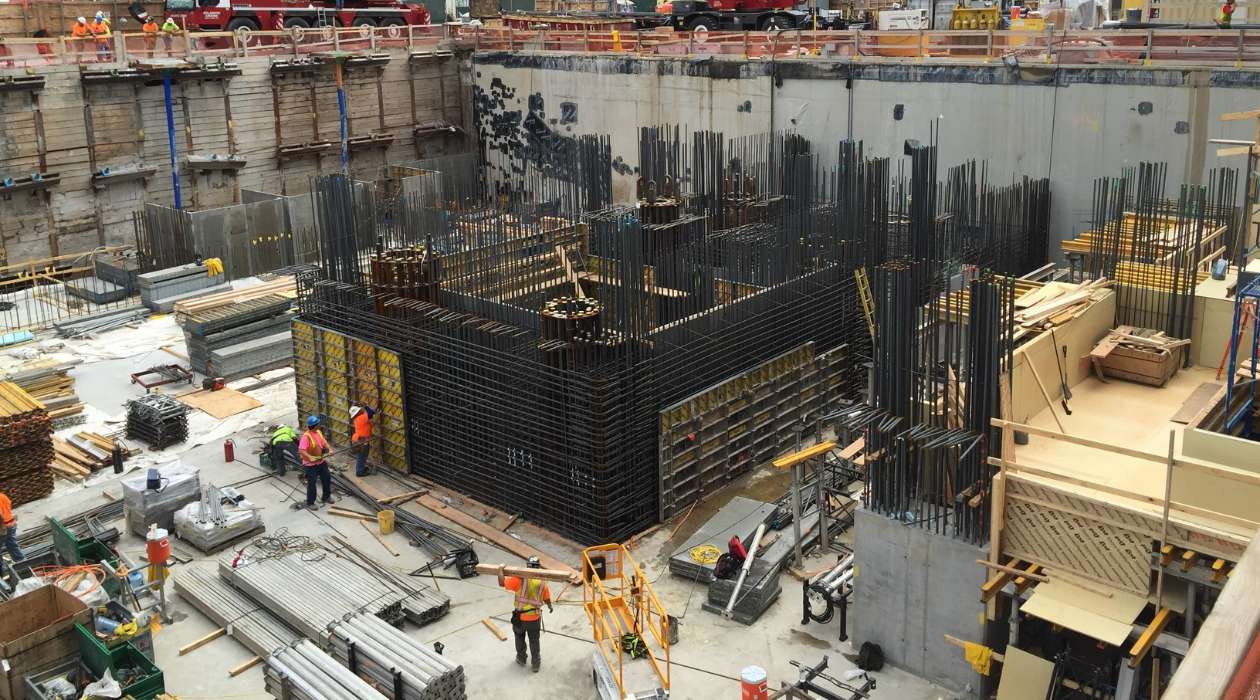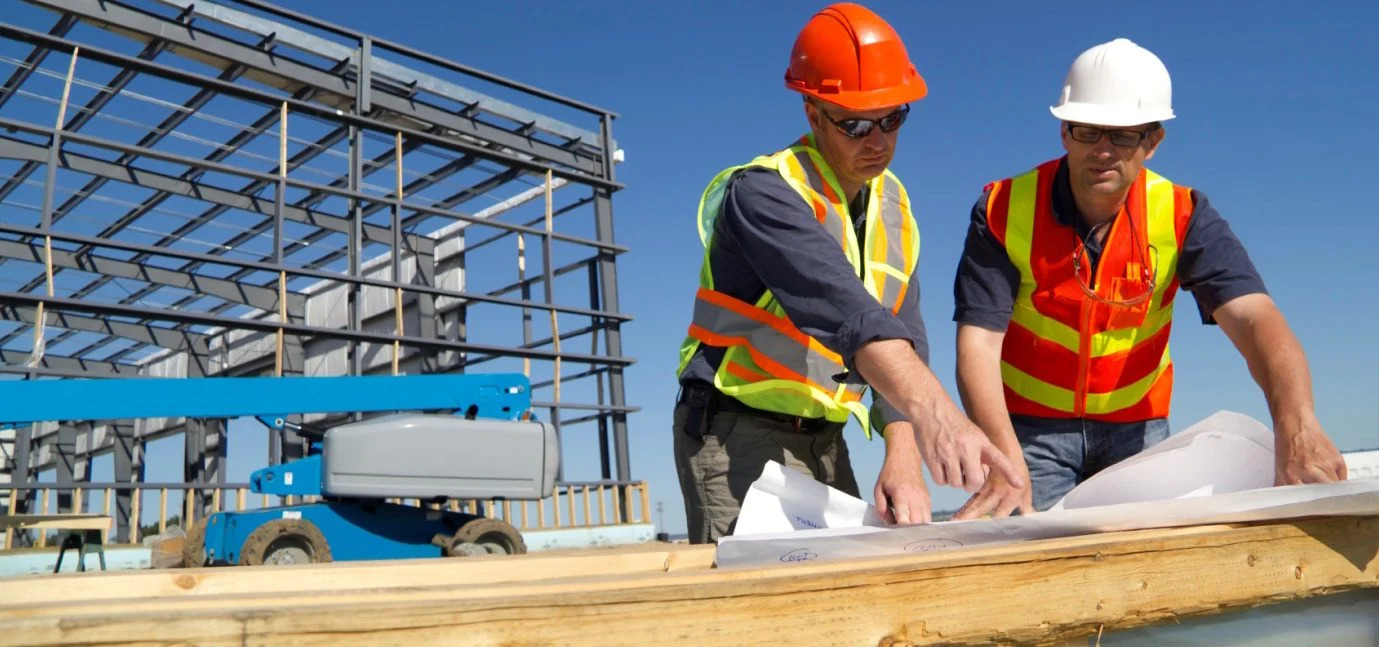Home>diy>Building & Construction>How To Value A Construction Company For Sale


Building & Construction
How To Value A Construction Company For Sale
Modified: February 25, 2024
Learn how to accurately value a construction company for sale with our comprehensive guide. Gain insights into the key factors that impact the value of building-construction businesses.
(Many of the links in this article redirect to a specific reviewed product. Your purchase of these products through affiliate links helps to generate commission for Storables.com, at no extra cost. Learn more)
Introduction
Valuing a construction company for sale is a critical step in the process of buying or selling a business. For both buyers and sellers, having a clear understanding of the company’s worth is essential to make informed decisions. The valuation process involves analyzing various factors, such as financial performance, assets and liabilities, market trends, and potential future cash flows.
In this article, we will explore the importance of valuing a construction company and delve into the essential factors to consider during the valuation process. Whether you are a construction company owner looking to sell your business or a buyer interested in acquiring a construction company, understanding the valuation process is crucial to ensure a fair and successful transaction.
Valuing a construction company goes beyond simply looking at its physical assets. While tangible assets like equipment, vehicles, and real estate are a significant part of the valuation, the financial performance and growth potential of the company play an equally important role. By assessing both quantitative and qualitative factors, a comprehensive valuation can be achieved, providing a realistic picture of the worth of the construction company.
During the valuation process, it is essential to consider the unique characteristics of the construction industry. The construction sector is known for its cyclical nature, with economic fluctuations impacting demand and profitability. Additionally, the complexity of construction projects and the industry’s reliance on skilled labor and materials contribute to the challenges faced by construction companies.
By taking these factors into account, a proper valuation can help buyers and sellers navigate these challenges and make informed decisions. For sellers, an accurate valuation ensures that the company is priced competitively, attracting potential buyers and maximizing the return on investment. On the other hand, buyers can rely on a thorough valuation to assess the financial health and potential growth opportunities of a construction company before making a purchase.
In the following sections of this article, we will explore the specific factors that should be considered when valuing a construction company. From analyzing the financial performance and estimating future cash flows to evaluating the company’s assets and liabilities and assessing market trends, a comprehensive valuation can provide a solid foundation for the transaction process.
Key Takeaways:
- Valuing a construction company involves a comprehensive analysis of financial performance, assets, liabilities, and future cash flows. Understanding market trends and conducting a DCF analysis are crucial for informed decision-making in the industry.
- Adjustments and risk assessment play a vital role in accurately valuing a construction company. Evaluating non-recurring items, working capital, and potential risks ensures a fair and successful transaction for both buyers and sellers in the industry.
Read more: How Do You Value A Construction Company
Importance of Valuing a Construction Company
Valuing a construction company is a crucial step in the buying or selling process, as it provides valuable insights into the financial health and potential future growth of the business. Here are several key reasons why valuing a construction company is of utmost importance:
- Informed decision-making: A comprehensive valuation allows both buyers and sellers to make informed decisions. For sellers, understanding the true worth of their construction company enables them to set a fair asking price and maximize their return on investment. Buyers can assess the value and potential risks of acquiring a construction company, helping them negotiate a suitable purchase price and determine if the investment aligns with their financial goals.
- Understanding financial performance: Valuing a construction company involves analyzing its financial statements, including balance sheets, income statements, and cash flow statements. This analysis provides insights into revenue streams, profitability, and expenses, allowing owners and potential buyers to gauge the company’s profitability and financial stability.
- Assessing growth potential: The valuation process also involves estimating the potential future cash flows of a construction company. By analyzing historical data, market trends, and upcoming projects, stakeholders can determine the growth potential of the business. This information is crucial for buyers who want to ensure a return on their investment and for sellers looking to showcase the growth prospects of their company.
- Negotiating power: An accurate valuation provides sellers with strong negotiating power. Armed with a valuation report that reflects the true value of their construction company, sellers can confidently negotiate with potential buyers, ensuring a fair and profitable transaction. On the other hand, buyers armed with a thorough valuation can negotiate a suitable purchase price based on their assessment of the company’s financial performance and growth potential.
- Attracting potential buyers/investors: A properly valued construction company is more likely to attract potential buyers or investors. Buyers are more inclined to engage with businesses that have a clear understanding of their worth and growth potential. This can result in a more competitive sales process, increased interest, and potentially higher offers for the seller.
Valuing a construction company involves a combination of financial analysis, evaluating assets and liabilities, assessing market trends, and estimating future cash flows. By conducting a comprehensive valuation, stakeholders gain a deeper understanding of the company’s worth, which is invaluable when making strategic business decisions, negotiating a fair selling price, or determining the feasibility of a potential acquisition.
Factors to Consider in Valuing a Construction Company
Valuing a construction company requires a thorough assessment of various factors that contribute to its overall worth. Several key factors should be considered during the valuation process:
- Financial Analysis: Analyzing the financial performance of a construction company is crucial in determining its value. This involves evaluating revenue streams, profitability, expenses, and cash flow. Key financial indicators such as gross profit margin, net profit margin, and return on investment should be examined to gain insight into the company’s financial health.
- Assets and Liabilities: Evaluating the company’s assets and liabilities provides an understanding of its tangible and intangible worth. Tangible assets include equipment, vehicles, land, and buildings, while intangible assets may include intellectual property or reputation. On the other hand, liabilities such as outstanding loans, contracts, and legal obligations should be assessed to determine the company’s financial obligations and potential risks.
- Estimating Future Cash Flows: Estimating the potential future cash flows of a construction company is essential in determining its value. This involves analyzing historical financial data, upcoming projects, market trends, and growth prospects. Projections should consider both best-case and worst-case scenarios to account for the cyclical nature of the construction industry and potential risks.
- Market Analysis and Industry Trends: An evaluation of the construction industry’s current market conditions and trends is crucial in assessing the company’s value. Factors such as demand for construction services, market competition, and regulatory changes should be analyzed to determine the company’s market positioning and growth potential.
- Comparable Sales and Market Multiples: Comparing the construction company’s financial performance and valuation metrics to similar businesses that have recently been sold provides valuable insights. Market multiples, such as price-to-earnings ratio or price-to-sales ratio, can be used to assess the company’s value relative to its peers in the industry.
- Discounted Cash Flow (DCF) Analysis: The DCF analysis considers the time value of money by discounting future cash flows to their present value. It is a commonly used valuation method that takes into account the risk and uncertainty of future cash flows, providing a more accurate estimate of a construction company’s value.
- Adjustments and Risk Assessment: Adjustments may need to be made to the company’s financial statements to reflect the true value of its assets and liabilities. Additionally, assessing potential risks, such as project delays, supply chain disruptions, or regulatory changes, is crucial in determining the company’s overall value.
Valuing a construction company requires a comprehensive analysis of both quantitative and qualitative factors. By carefully considering these factors, stakeholders can gain a realistic understanding of the company’s worth, enabling informed decision-making and facilitating a fair and successful transaction.
Financial Analysis of a Construction Company
Conducting a thorough financial analysis is a critical component of valuing a construction company. It provides valuable insights into the company’s financial health, profitability, and cash flow generation. Here are key aspects to consider in the financial analysis of a construction company:
- Revenue Streams: Analyzing the company’s revenue streams is essential to understand its sources of income. Construction companies usually generate revenue from various sources, such as construction contracts, maintenance services, or equipment rentals. Examining the diversity and stability of these revenue streams helps evaluate the company’s financial stability and growth potential.
- Profitability Measures: Key profitability measures, such as gross profit margin and net profit margin, provide insights into the company’s ability to generate profits from its operations. A high gross profit margin indicates that the construction company efficiently manages its direct costs, while a healthy net profit margin reflects its ability to control indirect costs and generate net income.
- Expenses: Analyzing the company’s expenses is crucial in understanding its cost structure. Construction companies have various expenses, including labor costs, materials, equipment maintenance, and overhead expenses. Examining the proportion of each expense category and identifying opportunities for cost optimization helps assess the company’s efficiency and profitability.
- Cash Flow Analysis: Evaluating the company’s cash flow is vital to understand its liquidity and ability to meet financial obligations. Analyzing the cash flow statement provides insight into the company’s operating cash flow, investing activities, and financing activities. Positive operating cash flow and healthy cash reserves indicate the company’s ability to manage day-to-day operations and invest in future growth.
- Financial Ratios: Calculating and analyzing various financial ratios helps assess the company’s financial health and performance. Examples of important ratios for construction companies include the current ratio (liquidity), debt-to-equity ratio (leverage), and return on assets (profitability). Comparing these ratios to industry benchmarks and historical data allows for a more comprehensive evaluation of the company’s financial position.
- Budgeting and Forecasting: Reviewing the company’s budgets and future financial projections provides insights into its growth prospects and financial planning. Understanding how the company sets budgets, forecasts revenue and expenses, and manages capital expenditures helps evaluate its strategic financial management and potential for future growth.
- Profitability by Project Type: Examining the profitability of different types of construction projects can shed light on the company’s expertise and market positioning. Analyzing the profitability of residential, commercial, or infrastructure projects helps assess the company’s ability to generate profits and attract a diverse range of clients.
By conducting a comprehensive financial analysis, stakeholders can gain a deeper understanding of a construction company’s financial performance, profitability, and growth potential. This analysis plays a crucial role in the valuation process, helping both buyers and sellers make informed decisions and negotiate a fair price.
Evaluating Assets and Liabilities
Assessing the assets and liabilities of a construction company is a vital aspect of valuing the business accurately. By evaluating these elements, stakeholders can understand the company’s financial position and estimate its worth. Here are key considerations when evaluating assets and liabilities:
- Tangible Assets: Tangible assets include physical items that hold value, such as land, buildings, equipment, and vehicles. It is essential to assess the condition, age, and market value of these assets. Evaluating the quality and functionality of the equipment and vehicles helps determine their residual value and potential for future use. Additionally, considering the current market value of land and buildings provides insights into the company’s real estate assets.
- Intangible Assets: Intangible assets may include brand reputation, intellectual property, patents, trademarks, or proprietary technology that contributes to the company’s competitive advantage. Valuing these assets can be more challenging as they do not have a physical presence. However, assessing their importance and market value is essential in determining the overall worth of the construction company.
- Inventory and Materials: Construction companies often maintain inventory and stock of raw materials, tools, and supplies necessary for their projects. Evaluating the quantity, quality, and market value of inventory and materials is crucial in assessing the company’s ability to complete ongoing projects and fulfill future contracts.
- Accounts Receivable: It is essential to review the company’s outstanding invoices and accounts receivable. Examining the payment terms, collection history, and aging of accounts receivable helps estimate the likelihood of receiving payments in a timely manner. Assessing any potential bad debts or delinquent accounts provides insights into possible risks and financial implications for the company.
- Liabilities: Evaluating the company’s liabilities is equally important in understanding its financial obligations and potential risks. Liabilities may include outstanding loans, lines of credit, mortgages, leases, or any other contractual obligations. It is crucial to assess the terms, interest rates, and repayment schedules of these liabilities and consider the impact they will have on the company’s cash flow.
- Contingent Liabilities: Contingent liabilities are potential obligations that may arise from pending legal disputes, warranty claims, or other unforeseen circumstances. These liabilities could have a significant impact on the company’s financial obligations. Assessing any potential contingent liabilities is essential to determine their financial impact and overall value of the construction company.
- Insurance Coverage: Examining the company’s insurance policies is crucial to determine the extent of coverage for potential risks, such as accidents, property damage, or litigation. Understanding the adequacy and validity of insurance coverage provides insights into the company’s risk management strategy and financial protection.
Evaluating the assets and liabilities of a construction company provides a comprehensive understanding of its financial position, potential risks, and overall worth. By considering tangible and intangible assets, inventory, accounts receivable, liabilities, and contingent liabilities, stakeholders can make informed decisions during the valuation process and ensure a fair and successful transaction.
Read more: How To Name A Construction Company
Estimating Future Cash Flows
Estimating future cash flows is a crucial component of valuing a construction company. By projecting the cash inflows and outflows expected to be generated by the business, stakeholders can assess its potential for growth and profitability. Here are key considerations when estimating future cash flows:
- Backlog and Contracts: Evaluate the company’s existing backlog of projects and contracts. This includes assessing the size, duration, and profitability of the contracts. A robust backlog indicates a steady stream of future revenue for the company.
- Market Demand and Industry Trends: Analyze the current market demand for construction services and potential industry trends. Consider factors such as population growth, urban development, infrastructure investments, and government policies. Understanding the market dynamics helps project the company’s future revenue potential.
- New Business Development: Take into account the company’s ability to secure new projects and contracts. Assess its reputation, marketing strategies, existing client relationships, and the capacity to bid on and win new opportunities. A proactive approach to business development enhances the company’s revenue generation potential.
- Inflation and Price Escalation: Consider the impact of inflation on the company’s costs and pricing structure. Anticipate potential price escalations in labor, materials, and other expenses. Inflation-adjusted cash flow projections provide a more accurate estimate of the company’s future financial performance.
- Risk Assessment: Identify and evaluate potential risks that could impact the company’s cash flow. Examples may include delays in project completion, disruptions in the supply chain, regulatory changes, or economic downturns. Assess the likelihood and potential impact of these risks on future cash flows.
- Capital Expenditure: Take into account the company’s planned investment in capital assets, such as new equipment or facility expansions. These investments impact cash flow by influencing the company’s operational efficiency and capacity to undertake new projects.
- Seasonality: Consider any seasonality in the construction industry that may affect the company’s cash flow. Construction activity may vary during different seasons, which should be factored into the cash flow projections.
- Competitive Landscape: Assess the competitive landscape and potential threats from competitors. This includes evaluating their market share, pricing strategies, and ability to attract clients. Understanding the competitive environment helps determine the company’s market positioning and revenue generation potential.
- Financial and Strategic Planning: Consider the company’s past financial performance and strategic plans. Review historical financial statements, budgets, and forecasts. Identify any patterns or trends that can be used to inform future cash flow projections.
Estimating future cash flows requires a combination of financial analysis, industry knowledge, and an understanding of the company’s competitive position. It is important to consider multiple scenarios, including best-case and worst-case scenarios, to account for potential uncertainties and risks. By conducting a comprehensive analysis of these factors, stakeholders can make informed decisions about the value and growth potential of the construction company.
When valuing a construction company for sale, consider factors such as the company’s financial performance, reputation, client base, and the value of its assets including equipment and real estate.
Market Analysis and Industry Trends
Conducting a market analysis and staying abreast of industry trends is crucial when valuing a construction company. Understanding the current market conditions and industry dynamics allows stakeholders to assess the company’s competitive position and growth potential. Here are key considerations when conducting a market analysis:
- Market Size and Growth: Determine the size of the construction market in which the company operates. Assess its historical growth rate and projected future growth. This information provides insights into the company’s potential revenue opportunities and the overall demand for construction services.
- Regional and Local Factors: Consider region-specific factors that may impact the construction industry. This includes local economic conditions, population growth, urban development initiatives, infrastructure investments, and government regulations.
- Market Segmentation: Analyze how the construction market is segmented and identify the company’s target market. Assess the competitive landscape within each segment and analyze market share, pricing strategies, and customer preferences to understand the company’s market positioning.
- Technological Advancements: Evaluate how technology is shaping the construction industry. This includes advancements in project management software, Building Information Modeling (BIM), construction automation, and other innovative solutions. Understanding how the company leverages technology and adapts to industry changes is essential for assessing its competitiveness.
- Sustainability and Green Building: Assess the growing demand for sustainable and eco-friendly construction practices. Evaluate the company’s ability to offer sustainable solutions and its commitment to green building principles. Consider how these factors may impact the company’s market share and growth opportunities.
- Competitor Analysis: Identify and analyze key competitors within the construction industry. Assess their market share, financial performance, capabilities, and competitive advantages. Understanding the strengths and weaknesses of competitors helps evaluate the company’s relative position and potential for growth.
- Client Relationships: Evaluate the company’s existing client relationships and its ability to attract new clients. Assess the company’s reputation, customer satisfaction, and track record of completing projects on time and within budget. Strong client relationships and a diverse client base contribute to the company’s market value.
- Industry Regulations: Consider the regulatory environment impacting the construction industry. Assess any changes in building codes, safety regulations, environmental standards, or government policies that may affect the company’s operations and growth potential.
- Economic Factors: Analyze broader economic factors such as interest rates, inflation rates, and overall market conditions. These factors influence the cost of borrowing, project financing, and the overall economic outlook, which in turn affect the construction industry’s growth and profitability.
- Industry Associations and Networks: Engage with industry associations and networks to gain insights into the latest industry trends, technological advancements, and market forecasts. These organizations can provide valuable market intelligence and networking opportunities.
By conducting a comprehensive market analysis and monitoring industry trends, stakeholders can gain a deeper understanding of the construction company’s competitive position, growth opportunities, and potential risks. This information is crucial for accurately valuing the company and making informed decisions during the buying or selling process.
Comparable Sales and Market Multiples
When valuing a construction company, analyzing comparable sales and using market multiples can provide valuable insights into its worth. Comparable sales involve examining transactions of similar construction companies that have recently been sold. Market multiples, on the other hand, are valuation ratios applied to financial metrics of the company. Here are key considerations when using comparable sales and market multiples:
- Identifying Comparable Sales: Find recent sales of construction companies that are similar in terms of size, geographic location, market focus, and business model. Look for transactions that are as close in time as possible to the valuation date. Multiple data sources, including industry databases, business brokers, and industry associations, can help identify relevant comparable sales.
- Financial Metrics: Examine the financial metrics of the comparable sales, such as revenue, net income, EBITDA (earnings before interest, taxes, depreciation, and amortization), and cash flow. These metrics provide a basis for comparison and help establish market valuation trends.
- Market Multiples: Calculate market multiples by dividing a financial metric of a comparable sale by the same metric of the construction company being valued. Common market multiples used in the construction industry include price-to-sales ratio, price-to-earnings ratio, and EV/EBITDA ratio. These multiples can provide a benchmark for estimating the value of the company based on its financial performance.
- Adjustments: Adjust the market multiples to account for any differences between the comparable sales and the company being valued. Factors such as size, growth rate, geographic location, market position, and unique characteristics should be considered. Adjustments help ensure a more accurate comparison and valuation.
- Income Approach: Use the market multiples within the income approach valuation method, such as the discounted cash flow (DCF) analysis. Apply the selected market multiples to key financial metrics of the construction company, such as projected future cash flows or EBITDA, to estimate its value.
- Limitations: Recognize the limitations of using comparable sales and market multiples. Each company is unique, and differences in financial performance, growth prospects, and risk levels can influence valuation. Additionally, market conditions and industry trends may evolve over time, affecting the relevance of comparable sales and market multiples.
- Additional Factors: Consider additional factors not captured by market multiples, such as the company’s reputation, intellectual property, client relationships, quality of management, and future growth potential. These qualitative aspects can significantly impact the value of the construction company.
- Expertise and Professional Advice: Engage the expertise of professionals, such as business valuation specialists, appraisers, or financial advisors, to assist in the analysis of comparable sales and the application of market multiples. Their knowledge and experience provide a more thorough and objective evaluation.
By examining comparable sales and using market multiples, stakeholders can gain a better understanding of the value of the construction company based on market trends and financial performance. However, it is important to combine this approach with other valuation methods and considerations to ensure a more comprehensive and accurate assessment.
Discounted Cash Flow (DCF) Analysis
The Discounted Cash Flow (DCF) analysis is a widely used valuation method that estimates the present value of a construction company by forecasting its future cash flows and discounting them back to their current value. The DCF analysis is based on the principle that the value of a business is determined by the cash flows it generates. Here are key aspects of conducting a DCF analysis:
- Forecasting Future Cash Flows: The first step is to estimate the future cash flows that the construction company is expected to generate. This involves projecting the revenue, operating expenses, taxes, and capital expenditures over a defined period. Accuracy and realism are essential in these projections.
- Estimating Terminal Value: To capture the long-term value of the construction company, a terminal value is estimated. The terminal value represents the value of future cash flows beyond the forecasted period. Common methods for estimating terminal value include the perpetual growth method or the multiple-based method.
- Time Value of Money: The DCF analysis considers the time value of money, recognizing that a dollar received in the future is worth less than a dollar received today. Therefore, cash flows projected in future periods are discounted to their present value using an appropriate discount rate.
- Discount Rate: The discount rate is used to determine the present value of future cash flows. It reflects the company’s cost of capital or the required rate of return for investors. The discount rate considers the risk associated with the construction industry and the company’s specific characteristics.
- Calculation of Present Value: Each projected cash flow and the terminal value is discounted back to its present value using the discount rate. The present values of all cash flows are then summed to estimate the intrinsic value of the construction company.
- Sensitivity Analysis: Conducting sensitivity analysis is important to assess the impact of changes in key assumptions on the estimated value. This involves testing the sensitivity of the valuation by varying factors such as the discount rate, revenue growth rate, or operating expenses.
- Comparing to Market Value: The estimated value obtained from the DCF analysis is compared to the market value or recent transactions of comparable companies. This comparison can provide further insights into the reasonableness of the DCF valuation and help refine the estimated value.
- Assumptions and Limitations: It is crucial to be transparent about the assumptions made during the DCF analysis and recognize the limitations of the method. Assumptions such as revenue growth rates, discount rates, and terminal value assumptions can significantly influence the estimated value.
- Expertise and Professional Input: Engage the expertise of financial analysts or business valuation specialists to ensure the accuracy and reliability of the DCF analysis. Their knowledge and experience can help refine the assumptions, select appropriate discount rates, and validate the projections.
By conducting a Discounted Cash Flow (DCF) analysis, stakeholders can estimate the intrinsic value of a construction company by considering its future cash flows and the time value of money. This method provides a rigorous and comprehensive approach to valuing the business. However, it is crucial to use realistic assumptions, apply appropriate discount rates, and conduct sensitivity analysis to ensure the accuracy and reliability of the valuation.
Read more: How To Register A Construction Company
Adjustments and Risk Assessment
When valuing a construction company, it is essential to make adjustments and conduct a thorough risk assessment. Adjustments are made to the company’s financial statements and valuation metrics to reflect the true value of its assets and liabilities. Risk assessment involves evaluating potential risks that may impact the company’s future performance. Here are key considerations when making adjustments and conducting risk assessment:
- Adjustments for Non-Recurring Items: Identify and adjust for any non-recurring or extraordinary expenses or revenues that may distort the company’s financial statements. These could include one-time legal expenses, asset write-offs, or gains from the sale of non-core assets. Eliminating these items provides a clearer picture of the company’s ongoing financial performance.
- Normalization Adjustments: Normalize the company’s financial statements by removing any non-operating or personal expenses that are unrelated to the core business. Examples may include excessive owner salaries, personal expenses charged to the company, or non-business-related travel expenses. Adjusting for these items ensures a more accurate representation of the company’s financial performance.
- Working Capital Adjustments: Evaluate the company’s working capital, such as accounts receivable, inventory, and accounts payable, and make adjustments as necessary. Assess the adequacy of working capital and consider any significant fluctuations that may impact the company’s cash flow and liquidity.
- Depreciation and Amortization: Review the company’s depreciation and amortization expenses and assess if they accurately reflect the useful life of the company’s assets. Adjustments may be necessary to align depreciation and amortization with the economic reality of the construction company’s assets and their remaining useful life.
- Risk Assessment: Identify and assess potential risks that may impact the construction company’s future performance. These risks could include project delays, labor shortages, materials price fluctuations, regulatory changes, or changes in market demand. Evaluate the potential impact of these risks on the company’s financial performance and adjust valuation accordingly.
- Market Risk: Evaluate the sensitivity of the construction company’s value to changes in market conditions. This includes analyzing the impact of economic downturns, interest rate fluctuations, or changes in the construction industry’s overall demand. Incorporate risk adjustments to reflect the level of market risk associated with the company.
- Competitive Risk: Assess the competitive landscape and any potential threats from competitors. Consider factors such as new entrants, technological advancements, or changes in customer preferences. Evaluate the company’s ability to maintain its market share and adjust the valuation accordingly.
- Legal and Compliance Risk: Evaluate the company’s legal and compliance environment. Assess any pending litigation, regulatory compliance issues, or potential legal liabilities that may impact the company’s financial performance. Adjust valuation to account for legal and compliance risks.
- External Factors: Consider external factors such as changes in government policies, environmental regulations, or geopolitical events that may impact the construction industry. Evaluate the potential impact of these factors on the company’s operations and adjust valuation accordingly.
- Scenario Analysis: Perform scenario analysis to assess the impact of different risk scenarios on the construction company’s value. This involves modeling the potential financial outcomes based on different combinations of risks and adjusting valuation based on the likelihood and severity of each scenario.
By making necessary adjustments to financial statements and conducting a thorough risk assessment, stakeholders can account for potential distortions and risks that may impact the value of a construction company. It is important to consider both quantitative and qualitative factors to ensure a comprehensive valuation that accurately reflects the company’s true worth.
Conclusion
Valuing a construction company for sale is a complex process that requires a comprehensive analysis of various factors. By assessing financial performance, evaluating assets and liabilities, estimating future cash flows, analyzing market trends, and considering adjustments and risks, stakeholders can determine the true worth of the business. This information is essential for buyers seeking to make informed investment decisions and sellers aiming to maximize their return on investment.
The financial analysis of a construction company provides insights into revenue streams, profitability, expenses, and cash flow. Understanding these financial indicators helps evaluate the company’s performance and assess its potential for growth and profitability. Additionally, evaluating assets and liabilities allows for an examination of tangible and intangible assets, inventory, accounts receivable, and liabilities, providing a clearer picture of the company’s financial position.
Estimating future cash flows is a crucial aspect of valuation, as it allows stakeholders to assess the company’s growth potential. Analyzing market conditions and industry trends provides insights into market size, growth rate, competitive landscape, and potential risks. Moreover, considering comparable sales and market multiples helps benchmark the company’s value against similar businesses in the industry.
The Discounted Cash Flow (DCF) analysis is a widely used valuation method that estimates the present value of a construction company by forecasting its future cash flows and discounting them to their current value. This method accounts for the time value of money and provides a comprehensive assessment of the company’s value.
The final valuation also incorporates adjustments to financial statements to remove non-recurring or non-operating items, normalize expenses, and consider working capital adjustments. Risk assessment is crucial in evaluating potential risks that may impact the company’s financial performance, such as market risks, competitive risks, or legal and compliance risks.
In conclusion, valuing a construction company requires a multi-faceted approach that considers financial analysis, asset evaluation, future cash flow estimation, market analysis, adjustments, and risk assessment. By thoroughly examining these factors, stakeholders can make informed decisions, confidently negotiate prices, and ensure a fair and successful transaction in the construction industry.
Frequently Asked Questions about How To Value A Construction Company For Sale
Was this page helpful?
At Storables.com, we guarantee accurate and reliable information. Our content, validated by Expert Board Contributors, is crafted following stringent Editorial Policies. We're committed to providing you with well-researched, expert-backed insights for all your informational needs.














0 thoughts on “How To Value A Construction Company For Sale”